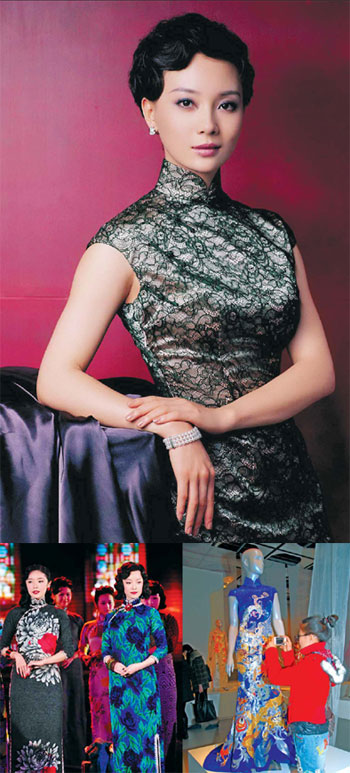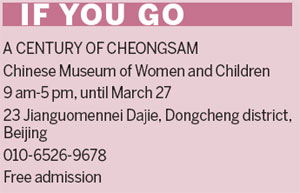A hundred years of collars
Updated: 2012-03-25 15:47
By Tiffany Tan (China Daily)
|
|||||||||||
 |
|
Top and above left: Cheongsams are favored by movie stars, especially for films set in the early 20th century. Provided to China Daily; Above right: A contemporary cheongsam exhibition displays how the dress has evolved since the early 20th century. Geng Feifei / China Daily |
Traditional, adaptable and smooth as silk, this dress remains the perfect wrap for a Chinese woman. Tiffany Tan re-visits the possibilities.
China's most popular traditional dress is not so traditional, after all. The cheongsam, that figure-hugging dress with a mandarin collar and slit skirt, which has become synonymous with Chinese beauty and elegance, is actually a product of "Western tailoring applied to traditional Chinese robes".
This is the first thing visitors learn from A Century of Cheongsam, a temporary fashion exhibition at the Chinese Museum of Women and Children through Tuesday. The exhibition shows, through 100 pieces mostly on loan from the China National Silk Museum in Hangzhou, how the dress has evolved since the early 20th century.
The cheongsam originated from two pieces of clothing from the late Qing Dynasty (1644-1911): sleeveless long vests worn over long-sleeved lined jackets. By the 1920s, the two pieces had been combined, resulting in a dress with long, wide sleeves, which the Chinese called qipao.
It soon became the latest thing in fashion, thanks to young women in the south. "The female students of Shanghai pioneered the qipao fashion," an exhibition sign says, quoting media reports from that time.
The earliest cheongsams were relatively loose - and then came the '30s, the "golden age" of the dresses.
Due to Western influences, they became tighter at the waist and lace was added as an ornament. Some were made with bell sleeves, double rows of covered buttons on the chest and tie-front knots, an integration of Western elements.
The dresses also started coming out in a variety of fabrics, both local and imported: multicolored satin and brocade, cotton prints, velvet, gauze and hand-embroidered cloths.
From 1932-35, cheongsam hemlines got so low they almost touched the ground. These types were dubbed the "broom cheongsams".
Around this time, upper-class Chinese, such as movie stars, socialites and intellectuals, began pairing the dress with foreign pieces of clothing, like fur coats, double-breasted blazers, shawls and sweaters.
The following decade saw the emergence of the cheongsam's mandarin collar, side overlap, shorter sleeves, as well as fasteners and zippers below the armpit.
"The tighter waist, breast darts, extended sleeves and other Western tailoring techniques reflect the simplicity and functionality of the cheongsams of the 1940s," another exhibition sign reads.
In the 1950s, during the early years of the People's Republic of China, the dress slowly disappeared from everyday use as austerity was emphasized in society.
Now, it is again back in the mainstream - but mostly as an outfit for special occasions, like wedding banquets, international events and holiday celebrations.

Guo Pei, 45, regarded as China's top haute couture designer, is also one of the names in high-end cheongsams. The hosts and performers of CCTV's annual Spring Festival Gala go to her for their gowns. So do A-list movie stars like Zhang Ziyi, for whom she designed a white, halter-neck cheongsam that is included in the exhibition.
The dress, worn by Zhang in Greece for the start of the torch relay for the 2008 Beijing Olympics, features an embroidered dragon and crane against white clouds, auspicious Chinese symbols. This piece is among the most elegant modern-day cheongsams on exhibit; the others are too frilly and flashy, especially when seen beside the decades-old classics.
"I try to get a good grasp of my client, including her appearance, figure and most of all, character," Guo says of her creative process. "Another very important consideration is that the dress must be comfortable."
Comfort in a dress with such a tight fit? This must prove what the exhibition organizers said on opening day: The cheongsam was designed for the Chinese woman's figure.
Contact the writer at tiffany@chinadaily.com.cn.